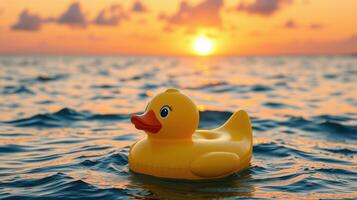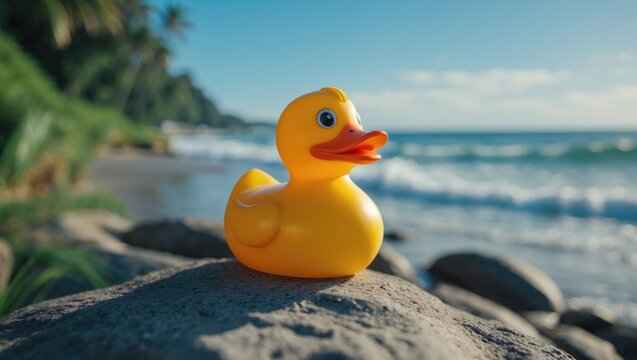Mind-Blowing Facts About Rubber Ducks You Didn’t Know
- Posted on

Have you ever wondered why a small yellow bath toy has captured global attention for over a century? Rubber ducks are more than just cute companions; they’re cultural icons, scientific tools, and even charity heroes. In this article, we’ll dive into fun facts about rubber ducks that go beyond bath time. From quirky history to world records, you’ll discover why these toys are so much more than plastic novelties.
Origins of Rubber Ducks: From Hard Rubber to Bath-Time Stars
The first rubber duck facts may surprise you: the earliest versions weren’t even designed to float.
- 1800s beginnings: Made of solid rubber, they were marketed as chew toys.
- Vulcanized rubber: Charles Goodyear’s invention made them resilient and waterproof.
- Patent era: In the 1940s, designer Peter Ganine patented the floating duck we know today, selling millions worldwide.
These innovations set the stage for rubber ducks to become a global household staple.
Rubber Ducks in Pop Culture and Psychology
Rubber ducks didn’t just stay in the bathtub; they entered mainstream culture.
- Sesame Street moment: Ernie’s song “Rubber Duckie” (1970) sold over a million copies and skyrocketed in popularity.
- Psychological comfort: Their simple design, bright color, and cheerful expression have been linked to reducing anxiety and creating positive associations, especially in children.
- Therapeutic use: Ducks are sometimes introduced in pediatric care settings to ease bath-time fears.
These facts about rubber ducks highlight their role in both entertainment and emotional well-being.
Collectibles, Records, and Giant Ducks

Rubber ducks have evolved into a collector’s dream and an artistic canvas.
- Record collections: Charlotte Lee holds the Guinness World Record with more than 9,000 ducks.
- Themed ducks: From superheroes to doctors, novelty ducks celebrate every personality.
- Art installations: Florentijn Hofman’s 100-foot inflatable “Mama Duck” has floated in harbors across the globe.
Quick Comparison: Ducks by the Numbers
| Fun Fact | Record/Stat | Source |
|---|---|---|
| Largest collection | 9,000+ ducks | Guinness World Records |
| Biggest duck sculpture | 100+ feet long, 1,000+ lbs | Hofman Installations |
| Most expensive collector duck | Over $1,000 at auction | Collector Market Reports |
Science, Environment, and Ocean Currents
When most people think about fun facts about rubber ducks, oceanography isn’t the first thing that comes to mind. Yet, these humble toys unexpectedly became scientific instruments that helped researchers better understand how the world’s oceans move.
The 1990s Shipping Spill That Made History
In 1992, a shipping container filled with bath toys, including nearly 29,000 rubber ducks, was accidentally lost at sea during a storm in the Pacific Ocean. What seemed like an industrial mishap soon turned into one of the most fascinating case studies in environmental science. Instead of sinking, the toys floated and began to drift along global currents. Over the years, ducks began washing ashore in unexpected places:
- Alaska within a few months
- Hawaii and Japan within a couple of years
- Australia and South America several years later
- Even as far as New England and the British coast, more than a decade afterward
These journeys provided invaluable data about the timing, strength, and direction of ocean currents, offering real-world confirmation of theoretical models.
Rubber Ducks as “Drifters” for Oceanography
Oceanographers typically rely on expensive, high-tech equipment called “drifters” to study how surface currents move. But in this case, nature provided 29,000 low-cost, bright yellow stand-ins. Nicknamed the “Friendly Floaties” by researchers, these ducks became accidental tools that scientists tracked across decades. The patterns they followed helped confirm the Great Pacific Garbage Patch and shed light on how plastics disperse globally.
Environmental Lessons Beyond the Data
While the scientific benefits were undeniable, the spill also underscored an uncomfortable truth: our oceans are filled with debris that doesn’t belong there. The long journeys of the rubber ducks made the public more aware of plastic pollution, marine litter, and the long-lasting impact of synthetic materials in aquatic ecosystems. Environmental groups began using the story to highlight the importance of reducing plastic waste and encouraging eco-friendly alternatives.
From Accident to Education
What began as an accident has since turned into a powerful teaching tool. Teachers, conservationists, and even museums have used the story of the lost rubber ducks to educate students and communities about ocean currents, climate change, and sustainability. This single event not only contributed to science but also helped inspire a global conversation about protecting our oceans.
A Legacy in Science and Awareness
In short, one of the most remarkable facts about rubber ducks is that they became unintentional heroes of environmental science. Their voyage across the seas continues to remind us that every object, no matter how small or playful, has a role to play in our understanding of the planet, and in our responsibility to care for it.
Why Rubber Ducks Continue to Capture Hearts

It’s rare for a simple toy to remain beloved for more than a century, but rubber ducks have done exactly that. Their universal appeal comes from their ability to connect with people on multiple levels: childhood wonder, adult nostalgia, and even social impact. These little bath companions are far more than novelty items; they’ve become enduring cultural symbols.
For Kids: Comfort and Play
One of the most enduring fun facts about rubber ducks is how they turn bath time, a moment that can often be stressful, into a playful, comforting ritual. Children are naturally drawn to the bright yellow color, which psychologists note is associated with happiness and optimism. The friendly shape and gentle squeak create a sense of reassurance, making bath time less about resistance and more about fun. Rubber ducks have been recommended by pediatric specialists as simple tools to ease bath anxiety and encourage imaginative play.
For Adults: Nostalgia and Collecting
Rubber ducks aren’t just for kids. Adults are often surprised by how strongly these toys connect them to childhood memories. Collectible ducks, designed as superheroes, celebrities, or seasonal mascots, add humor and personalization. For many, starting a collection of themed ducks is more than a hobby; it’s a way to reconnect with simple joys and share them with friends and family. That’s why rubber duck collections have exploded worldwide, with record-breaking enthusiasts gathering thousands of unique designs.
For Society: Symbols of Unity and Purpose
Perhaps the most remarkable rubber duck fact is how these toys have transcended personal use to represent community spirit. Large-scale rubber duck races have raised millions for charities around the world, while giant duck sculptures displayed in city harbors attract crowds and foster a sense of togetherness. Even scientists have relied on them, using spilled ducks from a cargo accident to map out ocean currents. These examples show that rubber ducks aren’t just toys; they’re tools for change, education, and shared joy.
A Timeless Connection
When you put all of this together, it becomes clear why rubber ducks remain so popular across generations. For kids, they provide comfort. For adults, they stir nostalgia. For society, they embody charity and curiosity. In short, rubber ducks are timeless companions that bridge the gap between childhood innocence and adult appreciation, ensuring their place in both playrooms and pop culture for years to come.
Le Petit Duck Shoppe: Your Destination for All Things Rubber Duck
At Le Petit Duck Shoppe, rubber ducks are an experience. Whether you’re a collector, gift-giver, or simply looking to brighten someone’s day, we’ve curated a lineup of duckies that combines whimsy with quality.
Why shop with us?
- Wide variety: From classic yellow ducks to limited-edition themed designs
- Collectible-worthy quality: Durable and designed to last
- Perfect gifts: Fun, nostalgic, and suitable for all ages
When you shop at Le Petit Duck Shoppe, you’re joining a global tradition of joy and creativity.
Conclusion
Rubber ducks may seem like simple bath-time toys, but their story proves otherwise. From their origins as 19th-century chew toys to becoming icons of pop culture, collectors’ items, and even tools of science, these little ducks have made a huge splash in history. They comfort children, spark nostalgia in adults, raise millions for charities, and even help scientists map the world’s oceans.
If you’re ready to bring home a piece of this tradition, explore the playful, collectible, and high-quality ducks at Le Petit Duck Shoppe. Whether you’re looking for a bath-time companion or a unique gift, you’ll find ducks that delight every generation.
Rubber ducks are proof that joy can float, and their legacy will continue for decades to come.
FAQ
When were rubber ducks invented?
Rubber ducks first appeared in the late 1800s, but the earliest versions looked very different from the floating bath toys we know today. They were made of hard rubber and marketed mainly as chew toys for children. It wasn’t until the 1940s that designer Peter Ganine patented the modern floating duck, selling millions and cementing the toy’s popularity. This shift turned the duck into a staple of bath time across households. So when people ask for fun facts about rubber ducks, the surprising truth is that they started as solid toys before becoming buoyant companions.
Why are rubber ducks yellow?
The classic yellow design of rubber ducks isn’t accidental; it’s rooted in psychology and marketing. Yellow is a bright, cheerful color that naturally attracts attention and is often associated with joy, optimism, and playfulness. More importantly, yellow mirrors the appearance of real ducklings, making the toy instantly recognizable and appealing to children. Studies in child development show that vibrant colors like yellow can stimulate positive emotions and create a sense of comfort. That’s why, among all rubber duck facts, their sunny hue is one of the most consistent and enduring design choices, making bath time feel warm and friendly.
Are rubber ducks safe for kids?
Rubber ducks are generally considered safe toys for children, but parents need to choose wisely. Look for ducks made from BPA-free, non-toxic materials that won’t release harmful chemicals into bathwater. High-quality options, like those sold at Le Petit Duck Shoppe, prioritize safety without sacrificing fun. One common tip is to avoid ducks with holes on the bottom, since trapped water can lead to mold growth. By selecting quality ducks from trusted shops, parents can ensure bath time stays both fun and hygienic. Safety and quality always go hand-in-hand when it comes to children’s bath time.
What is the largest rubber duck race?
Rubber duck races are community events where thousands of ducks are released into rivers or lakes to “race” downstream, often raising money for charity. The largest recorded event featured an astonishing 250,000 ducks floating along London’s River Thames. These races capture attention not just because of the spectacle, but because they blend family fun with fundraising. Communities worldwide, from the U.S. to Europe, host annual duck races, raising millions of dollars for children’s hospitals, disaster relief, and local projects. Among the many facts about rubber ducks, their role in charity events stands out as proof that small toys can make a huge difference.
Can rubber ducks teach science?
Surprisingly, yes! Rubber ducks have played a major role in oceanography. In 1992, nearly 29,000 bath toys, including ducks, were accidentally spilled into the Pacific Ocean. Scientists tracked where these ducks washed up, spanning Alaska, Australia, and even the U.K., to study ocean currents. This unplanned experiment gave researchers new insights into how plastics travel across the globe, helping confirm models of circulation like the Great Pacific Garbage Patch. Today, the story is often used in classrooms to spark discussions about environmental science and sustainability. It’s one of the most fascinating rubber duck facts, proving these toys can serve serious scientific purposes.
